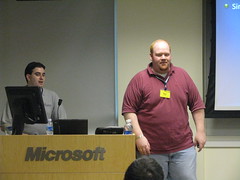Recently (e.g. an hour ago :-) I was having a discussion on Twitter with Sahil Malik about the virtues of a eBook reader vs. reading an electronic book on something like a laptop. It got me thinking, is the eBook worth reading?

So is this relatively new form factor worth considering? Short answer: yes. Long answer: it depends.
Pros:
- More portable than a laptop
- Longer batter life than a phone or laptop (days vs. hours)
- Form factor more like a book; easy to hold
- Larger screen than a phone, smaller form factor than a laptop
- Lower glare than an LCD screen
- No backlight to fatigue the eyes and consume power
- Simplicity – it is for reading, not for much else. It’s not a replacement for a laptop, it’s a replacement for a book
- Ability to hold hundreds of books and periodicals instead of having to lug around printed material
Cons:
- Hardware cost – readers are still upwards of $300 or more
- Content cost – books aren’t necessarily cheaper than paperbacks, newspapers aren’t necessarily cheaper than home delivery
- Content selection – limited vs. print, limited newspaper and magazine options and even within them less content per publication
- Standardization – Content spread out amongst different readers, not available on all, different formats. Though there are some standards like ePub and PDF, but they still can contain…
- DRM – limits display and sharing of eBooks, even with yourself
- Immature – the technology, while not brand new, is still in its infancy
In the next year, I hope to see a big leap forward in eBook readers. Features that would make it a much better platform:
- Touch screens (already appearing on some Sony Reader models)
- Color (not necessary but might be nice)
- Better navigation of books, newspapers, and magazines (may come with the touch screen interface)
- Better formatting for newspapers and magazines
- More selection
- Less DRM
- More wireless
- More sharing, less restrictions (one can dream)
- Lower entry cost
Much like the early days of MP3 players, eBook readers are in the phase where they’re still not for everyone. However, in a few years more people will have them and understand why they might be beneficial over other form factors.
This is a good review in PC World that summarizes the state of eBook readers pretty well. They don’t have a Nook review on there (yet) so you should add that to the mix.
I like the Nook because it’s more open than the Kindle, at least at the moment. I see the Kindle right now as similar to the iPod/iTunes experience a few years back when DRM ruled.
The Nook is still full of DRM, but may help open up things to less DRM or at least more open DRM, where you can buy eBooks from multiple stores on the reader itself and then read them on whatever device you have (other readers, phone, computer). You can sort of do this with the Nook/B&N eBooks—there are readers for PC/Mac, Blackberry, and iPhone, but not for Android (strangely), Palm, or Windows Mobile.
The Nook is based on Android, and I’m hoping that Barnes and Noble opens the platform to 3rd party development to help enhance the reading and browsing experience.
eBook readers could be a boon for the office one day, as well. Instead of printing that 100 page proposal or 1000 page manual, you could wirelessly sync it from your document management system to your eBook. Then you can read and annotate it using a touch screen/stylus and then sync back the comments to your document management system. All comments could be consolidated back as notes in Word or PDF format, and the author can then easily make the necessary changes. Voila! Finally, the paperless office! (Again, one can dream :-)

 The most recent iteration of the SharePoint Saturday franchise,
The most recent iteration of the SharePoint Saturday franchise, 



